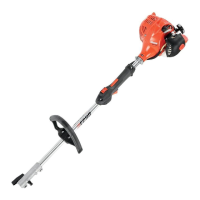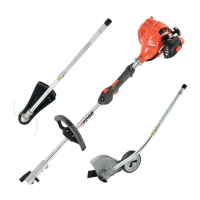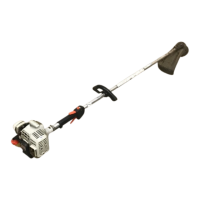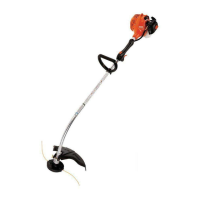© 06/2020 ECHO Incorporated X7152270100
14
QUICK START GUIDE / GUÍA DE INICIO RÁPIDO / GUIDE DE DÉMARRAGE
RAPIDE
PAS-225 / PAS-2620
Pro Attachment Series™
Use only ECHO approved parts. Failure to use the correct parts can
cause the blade to y o. Seriously injury to the operator and / or
bystanders can occur.
Before Each Use When Using A Blade:
• Verify the handles are installed according to the manufacturers
instructions. Use only ECHO approved parts. Failure to use the correct
parts can cause the blade to y o. Seriously injury to the operator
and / or bystanders can occur.
• Arbor diameter of upper blade plate must match arbor diameter of
blades.
• For barrier bar, follow installation instructions.
• Make sure blade is secured properly.
• A new cotter pin is required each time a blade is installed.
• Shoulder harnesses can be used on all trimmers and brushcutters to
reduce operator fatigue. Brushcutters over 7.5 kg (16.5 lbs.) dry weight
(without fuel) and U- handle brushcutters REQUIRE a double shoulder
harness.
Note: The barrier bar is used to restrict rearward movement of the unit. The
barrier bar is not a handle and should not be gripped when using or
carrying the unit.
Blade Selection
The type of blade used MUST be matched to the type and size of material
cut. An improper or dull blade can cause serious personal injury. Blades
MUST be sharp. Dull blades increase the chance of kick-out and injury to
yourself and bystanders. Never use an edging blade, circular saw blade,
or any other type of unapproved blade.
• 3-Tooth Grass/Weed Blades can be used wherever the nylon line head
is used. DO NOT use this blade for heavy weeds or brush.
• 8 Tooth Weed/Grass Blade is designed for grass, garden debris and
thick weeds up to 19 mm (0.75 in.) diameter. DO NOT use this blade for
brush or heavy woody growth.
• 80 Tooth Brush Blade is designed for cutting brush and woody growth
up to 13 mm (0.5 in.) diameter.
• 22 Tooth Clearing Blade is designed for dense thickets and saplings
up to 64 mm (2.5 in.) diameter.
A trimmer-brushcutter with a metal blade can cause serious injuries if
handled improperly.
Always use extreme care when carrying or
handling the equipment to avoid contact with the
cutting edges of the blade. Use the optional blade
cover when unit is not in use.
Keep blades in protective packaging until ready
to install. Store blades safely after removal to
prevent injury from accidental contact.
Use blade protectors to protect blade teeth during
unit transportation.
Use Shoulder/Waist Harness
Use of the shoulder/waist harness is
recommended for ALL Trimmer/brushcutter
use, not just blade operation. The shoulder/
waist harness when used in a trimming
operation with nylon line head suspends
the trimmer from the operator’s shoulder
and reduces operator fatigue.
During blade operation, the same fatigue
reduction is achieved. Safety to the
operator is also enhanced by reducing
the possibility of blade contact with the
operator’s hands and feet by restricting
trimmer movement.
Make sure the warning sign on the back of
the shoulder harness can be read easily.
Note: In case of Emergency, disconnect the trimmer from the harness.
Operation with Edger
Before edging, be sure to read and understand the entire online
Operator’s Manual to avoid serious injury.
Edger Blade Adjustment and Operation Techniques
1. Before edging, water the area to soften the ground to make edging easier.
2. Before edging, check the area and remove all obstacles and objects that
could be thrown.
3. Plan to edge regularly to make it easier to keep a neat edge and to avoid
having to make more than one pass.
Note: Blade depth can have to be adjusted due to dierences in height
between the hard surface and the top of the grass.
The complete unit, specically the drive shaft
assembly and muer exhaust area can become
very hot during use. Avoid contact during and
immediately after operation, otherwise serious
personal injury can result.
Never adjust blade height with engine running,
otherwise serious personal injury can result.
A
4. Loosen adjustment knob (A).
Move wheel up to increase
cutting depth, or down to
decrease cutting depth. A depth
of 13 mm (0.5 in.) is optimal.
Tighten adjustment knob (A).
5. Before edging, plan your
direction of travel so that the
unit will always be positioned
on your right side and so that
you walk on a hard surface
whenever possible.
6. Position edger as shown.
7. When starting to edge, run
the engine at full throttle, and
lower the blade gently into the
ground, being careful not to hit
the concrete with the blade.
8. Don’t force the blade. Move
only as quickly as the blade
will allow.
Operation with Blower
Moving parts can amputate ngers or cause severe injuries. Keep hands,
clothing and loose objects away from all openings. Always stop engine,
disconnect spark plug, and make sure all moving parts have come
to a complete stop before removing obstructions, clearing debris, or
servicing unit. Blower housing can contain shredder blades and other
sharp edges that can cause serious injuries if touched, even if engine is
o and blades are not moving. Wear gloves to protect hands from sharp
edges and hot surfaces.
Always wear safety glasses, hearing protection and a face lter mask or
serious personal injury can result. Do not point the blower pipe in the
direction of people or pets.
This blower should be used for clearing leaves, grass, and dust in yards,
gardens, driveways, and parking lots only.
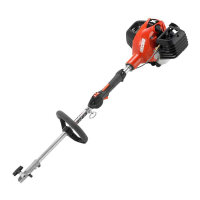
